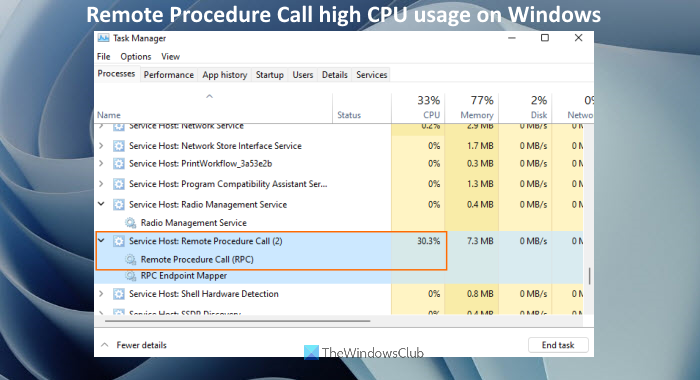This post helps to solve the Remote Procedure Call (RPC) high CPU usage problem on Windows 11/10 computer. Some users have this issue that while this service is running, it causes high CPU usage about 30% or more. Because of this, Windows hangs, and users are not able to use their computers properly. If you are also facing such a problem, then the solutions covered in this post might come in handy.

Remote Procedure Call is a technology for creating client and server programs by establishing a connection for communication with each other. The service runs in the background as many Windows OS procedures depend on it. You can easily check its CPU, network, disk usage, etc., in the Processes tab of Task Manager. If for some reason, it is causing high CPU usage, then you can try the solutions listed in this post to fix that issue.
Remote Procedure Call High CPU Usage on Windows 11/10
If your computer’s CPU usage is getting high because of the Remote Procedure Call service, then you can try the following solutions:
- Run System File Checker
- Repair System Image using DISM
- Update Network Drivers
- Run Network Troubleshooters
- Troubleshoot in Clean Boot State
- Use the Cloud Reset option to repair Windows.
Let’s check all these solutions one by one.
1] Run System File Checker
System File Checker is a built-in command-line utility of Windows 11/10 OS that helps to fix corrupt Windows system files. If some system files are damaged for some reason, then that can affect system performance and it might be the reason that RPC service is causing high CPU usage. In such a case, you should run System File Checker tool to restore corrupt system files and see if it helps.
2] Repair System Image using DISM
DISM (stands for Deployment Image Servicing and Management) is also a built-in command-line tool of Windows 11/10 that is helpful in repairing Windows system image as well as Windows Component Store. If a damaged system image is causing this problem, then you need to run DISM tool to repair Windows system image and see if the problem is gone.
3] Update Network Drivers
Another solution that might work to get rid of this problem is by updating network drivers. There are multiple ways to update network drivers like downloading them from Windows Optional updates section, using some third-party driver updater software, etc.
4] Run Network Troubleshooters
If there is some network-related problem that is affecting RPC service which in turn is causing high CPU usage, then you should try the troubleshooters available to fix network-related problems in Windows 11/10. That might work for you.
5] Troubleshoot in Clean Boot State
When you run your computer in Clean Boot State, it starts your computer with only a minimal set of startup programs and drivers. This helps to find out if there is some background program, game, or other items, that are causing the issue you are facing. So, first, troubleshoot in Clean Boot State. If your computer runs well and CPU usage is normal, then you need to manually find out exactly which tool or program is causing this problem and disable or remove it from your computer.
6] Use the Cloud Reset option to repair Windows
If the problem continues, then you should use the Cloud Reset option to reset or reinstall Windows. The Cloud Reset option in Windows 11/10 lets you download system files from the servers of Microsoft. You don’t need a local recovery image or anything. Everything is downloaded from the cloud and then Windows is installed.
Should I disable Remote Procedure Call?
A lot of services or Windows procedures depend on Remote Procedure Call service such as Print Spooler, Protected Storage, Network Connections, etc. Disabling RPC service will make such procedures stop work and then you won’t be able to use your computer properly. Therefore, it is recommended that you should not disable RPC or Remote Procedure Call.
How do I investigate high CPU usage in Windows?
You can investigate high CPU usage in Windows 11/10 computers using the Task Manager. After opening the Task Manager window, access the Performance tab, and you will be able to check the overall CPU usage, memory usage, etc., of your computer. If you want to check which process is consuming high CPU usage, then you need to switch to the Processes tab of Task Manager. There, you can see the CPU usage of each process separately and in real-time.
Related posts: